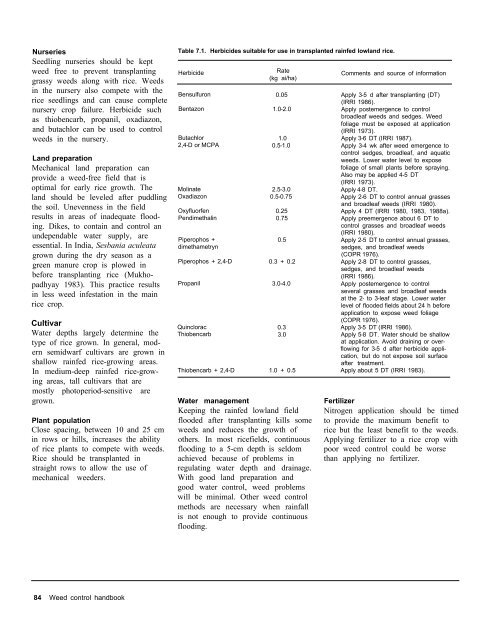A handbbok on Weed Control in Rice.pdf
A handbbok on Weed Control in Rice.pdf
A handbbok on Weed Control in Rice.pdf
You also want an ePaper? Increase the reach of your titles
YUMPU automatically turns print PDFs into web optimized ePapers that Google loves.
Nurseries<br />
Seedl<strong>in</strong>g nurseries should be kept<br />
weed free to prevent transplant<strong>in</strong>g<br />
grassy weeds al<strong>on</strong>g with rice. <strong>Weed</strong>s<br />
<strong>in</strong> the nursery also compete with the<br />
rice seedl<strong>in</strong>gs and can cause complete<br />
nursery crop failure. Herbicide such<br />
as thiobencarb, propanil, oxadiaz<strong>on</strong>,<br />
and butachlor can be used to c<strong>on</strong>trol<br />
weeds <strong>in</strong> the nursery.<br />
Land preparati<strong>on</strong><br />
Mechanical land preparati<strong>on</strong> can<br />
provide a weed-free field that is<br />
optimal for early rice growth. The<br />
land should be leveled after puddl<strong>in</strong>g<br />
the soil. Unevenness <strong>in</strong> the field<br />
results <strong>in</strong> areas of <strong>in</strong>adequate flood-<br />
<strong>in</strong>g. Dikes, to c<strong>on</strong>ta<strong>in</strong> and c<strong>on</strong>trol an<br />
undependable water supply, are<br />
essential. In India, Sesbania aculeata<br />
grown dur<strong>in</strong>g the dry seas<strong>on</strong> as a<br />
green manure crop is plowed <strong>in</strong><br />
before transplant<strong>in</strong>g rice (Mukho-<br />
padhyay 1983). This practice results<br />
<strong>in</strong> less weed <strong>in</strong>festati<strong>on</strong> <strong>in</strong> the ma<strong>in</strong><br />
rice crop.<br />
Cultivar<br />
Water depths largely determ<strong>in</strong>e the<br />
type of rice grown. In general, mod-<br />
ern semidwarf cultivars are grown <strong>in</strong><br />
shallow ra<strong>in</strong>fed rice-grow<strong>in</strong>g areas.<br />
In medium-deep ra<strong>in</strong>fed rice-grow-<br />
<strong>in</strong>g areas, tall cultivars that are<br />
mostly photoperiod-sensitive are<br />
grown.<br />
Plant populati<strong>on</strong><br />
Close spac<strong>in</strong>g, between 10 and 25 cm<br />
<strong>in</strong> rows or hills, <strong>in</strong>creases the ability<br />
of rice plants to compete with weeds.<br />
<strong>Rice</strong> should be transplanted <strong>in</strong><br />
straight rows to allow the use of<br />
mechanical weeders.<br />
84 <strong>Weed</strong> c<strong>on</strong>trol handbook<br />
Table 7.1. Herbicides suitable for use <strong>in</strong> transplanted ra<strong>in</strong>fed lowland rice.<br />
Herbicide<br />
Bensulfur<strong>on</strong><br />
Bentaz<strong>on</strong><br />
Butachlor<br />
2,4-D or MCPA<br />
Mol<strong>in</strong>ate<br />
Oxadiaz<strong>on</strong><br />
Oxyfluorfen<br />
Pendimethal<strong>in</strong><br />
Piperophos +<br />
dimethametryn<br />
Piperophos + 2,4-D<br />
Propanil<br />
Qu<strong>in</strong>clorac<br />
Thiobencarb<br />
Thiobencarb + 2,4-D<br />
Rate<br />
(kg ai/ha)<br />
0.05<br />
1.0-2.0<br />
1.0<br />
0.5-1.0<br />
2.5-3.0<br />
0.5-0.75<br />
0.25<br />
0.75<br />
0.5<br />
0.3 + 0.2<br />
3.0-4.0<br />
0.3<br />
3.0<br />
1.0 + 0.5<br />
Water management<br />
Keep<strong>in</strong>g the ra<strong>in</strong>fed lowland field<br />
flooded after transplant<strong>in</strong>g kills some<br />
weeds and reduces the growth of<br />
others. In most ricefields, c<strong>on</strong>t<strong>in</strong>uous<br />
flood<strong>in</strong>g to a 5-cm depth is seldom<br />
achieved because of problems <strong>in</strong><br />
regulat<strong>in</strong>g water depth and dra<strong>in</strong>age.<br />
With good land preparati<strong>on</strong> and<br />
good water c<strong>on</strong>trol, weed problems<br />
will be m<strong>in</strong>imal. Other weed c<strong>on</strong>trol<br />
methods are necessary when ra<strong>in</strong>fall<br />
is not enough to provide c<strong>on</strong>t<strong>in</strong>uous<br />
flood<strong>in</strong>g.<br />
Comments and source of <strong>in</strong>formati<strong>on</strong><br />
Apply 3-5 d after transplant<strong>in</strong>g (DT)<br />
(IRRI 1986).<br />
Apply postemergence to c<strong>on</strong>trol<br />
broadleaf weeds and sedges. <strong>Weed</strong><br />
foliage must be exposed at applicati<strong>on</strong><br />
(IRRI 1973).<br />
Apply 3-6 DT (IRRI 1987).<br />
Apply 3-4 wk after weed emergence to<br />
c<strong>on</strong>trol sedges, broadleaf, and aquatic<br />
weeds. Lower water level to expose<br />
foliage of small plants before spray<strong>in</strong>g.<br />
Also may be applied 4-5 DT<br />
(IRRI 1973).<br />
Apply 4-8 DT.<br />
Apply 2-6 DT to c<strong>on</strong>trol annual grasses<br />
and broadleaf weeds (IRRI 1980).<br />
Apply 4 DT (IRRI 1980, 1983, 1988a).<br />
Apply preemergence about 6 DT to<br />
c<strong>on</strong>trol grasses and broadleaf weeds<br />
(IRRI 1980).<br />
Apply 2-5 DT to c<strong>on</strong>trol annual grasses,<br />
sedges, and broadleaf weeds<br />
(COPR 1976).<br />
Apply 2-8 DT to c<strong>on</strong>trol grasses,<br />
sedges, and broadleaf weeds<br />
(IRRI 1986).<br />
Apply postemergence to c<strong>on</strong>trol<br />
several grasses and broadleaf weeds<br />
at the 2- to 3-leaf stage. Lower water<br />
level of flooded fields about 24 h before<br />
applicati<strong>on</strong> to expose weed foliage<br />
(COPR 1976).<br />
Apply 3-5 DT (IRRI 1986).<br />
Apply 5-8 DT. Water should be shallow<br />
at applicati<strong>on</strong>. Avoid dra<strong>in</strong><strong>in</strong>g or overflow<strong>in</strong>g<br />
for 3-5 d after herbicide applicati<strong>on</strong>,<br />
but do not expose soil surface<br />
after treatment.<br />
Apply about 5 DT (IRRI 1983).<br />
Fertilizer<br />
Nitrogen applicati<strong>on</strong> should be timed<br />
to provide the maximum benefit to<br />
rice but the least benefit to the weeds.<br />
Apply<strong>in</strong>g fertilizer to a rice crop with<br />
poor weed c<strong>on</strong>trol could be worse<br />
than apply<strong>in</strong>g no fertilizer.











